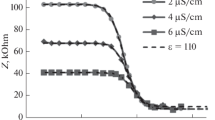Experimental and theoretical studies of the electrophysical characteristics of water with different concentrations of conductive impurity, including the complex dielectric permittivity, complex conductivity, and complex impedance spectra are performed at frequencies in the range from 20 Hz to 40 GHz. It is demonstrated that the complex dielectric permittivity spectrum at frequencies in the range 500 MHz – 40 GHz is well described by the Debye model with a single relaxation time. In the low-frequency range, one more region of dispersion is observed caused by the phenomena occurring on the liquid-electrode interface. The characteristics of this dispersion region depend significantly on the dc electrical conductivity. It is demonstrated that in the examined frequency range, the influence of the interface phenomena on the complex impedance spectra of water with conductive impurity are well described by adding the impedance of an constant phase element. For the examined samples, the electrophysical characteristics and the parameters of the constant phase element are determined. The static dielectric permittivity and the parameters characterizing the double electric layer increase with the electrical conductivity.
Similar content being viewed by others
References
D. N. Gadan, V. A. Rana, S. P. Bhatnagar, et al., Ind. J. Pure Appl. Phys., 50, 405–410 (2012).
W. Ellison, A. Balana, G. Deblos, et al., Radio Sci., 33 (3), 639–648 (1998).
E. Y. Korovin, T. D. Kochetkova, A. A. Pavlova, and V. I. Suslyaev, Proc. SPIE, 10035, 100357 (2016).
V. I. Suslyaev, P. F. Tarasenko, A. V. Zhuravlev, and V. A. Zhuravlev, Russ. Phys. J., 42, No. 11, 935–941 (1999).
T. L. Chelidze, A. I. Derevyanko, and O. D. Kurilenko, Electric Spectroscopy of Heterogeneous Systems [in Russian], Naukova Dumka, Kiev (1977).
D. Eiscnberg and W. Kauzmann, The Structure and Properties of Water, Clarendon Press, Oxford (2005).
K. Ya. Kondrat’ev, Meteorological Sensing of the Underlying Surface from Space, Gidrometeoizdat, Leningrad (1979).
R. King and G. Smith, Antennas in Material Media. Book 1 [Russian translation], Mir, Moscow (1984).
B. A. Belyaev and N. A. Drokin, Fiz. Tverd. Tela, 57, No. 1, 170–175 (2015).
F. Batalioto, A. R. Duarte, G. Barbero, and A. M. F. Netof, J. Phys. Chem. В, 114, 3467–3471 (2010).
J. R. Macdonald, Solid State Ionics, 13, 147–149 (1984).
U. Barbero, M. Becchi, and F. C. M. Freire, J. Appl. Phys., 104, 114111 (2008).
K. S. Cole and R. H. Cole, J. Chem. Phys., 9, 341–351 (1941).
Author information
Authors and Affiliations
Corresponding author
Additional information
Translated from Izvestiya Vysshikh Uchebnykh Zavedenii, Fizika, No. 11, pp. 40–46, November, 2017.
Rights and permissions
About this article
Cite this article
Zhuravlev, V.A., Suslyaev, V.I., Zhuravlev, A.V. et al. Analysis of Dielectric Spectra of Water with Conductive Impurities in a Wide Frequency Range. Russ Phys J 60, 1893–1900 (2018). https://doi.org/10.1007/s11182-018-1299-4
Received:
Published:
Issue Date:
DOI: https://doi.org/10.1007/s11182-018-1299-4




